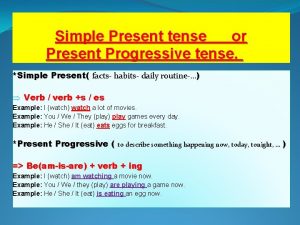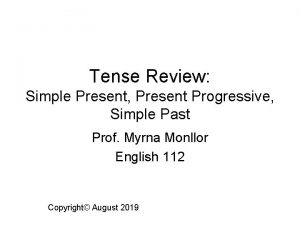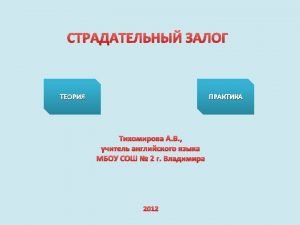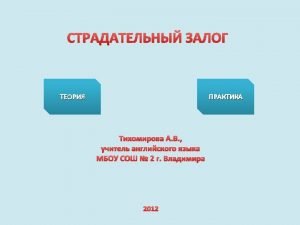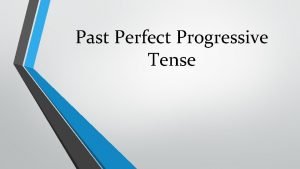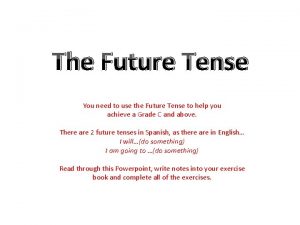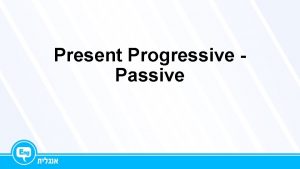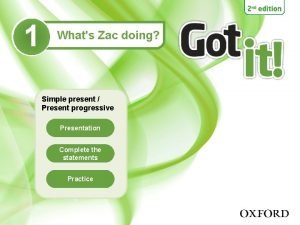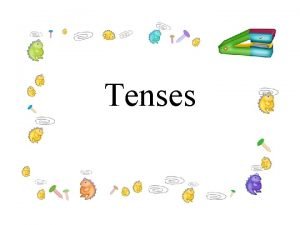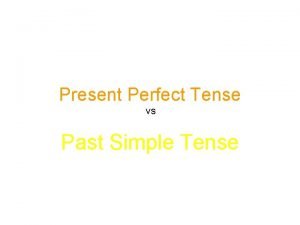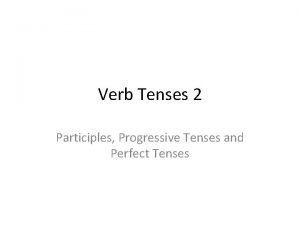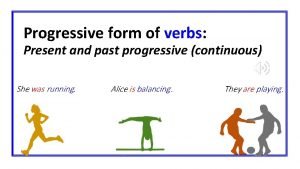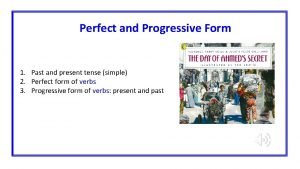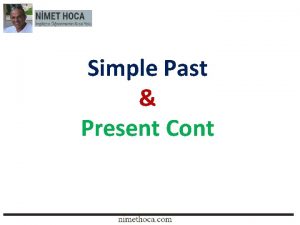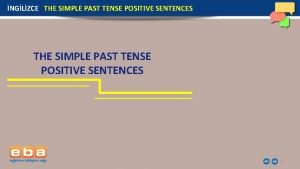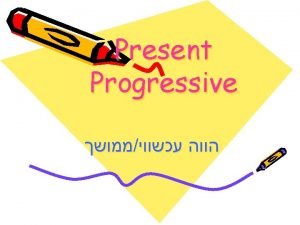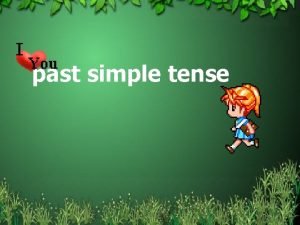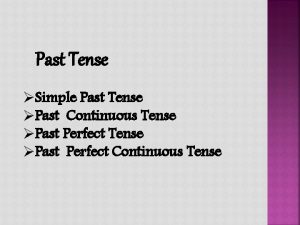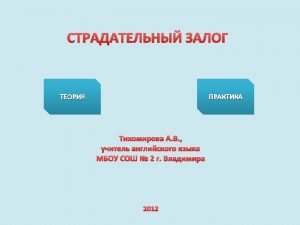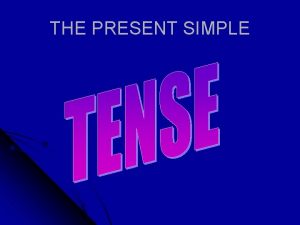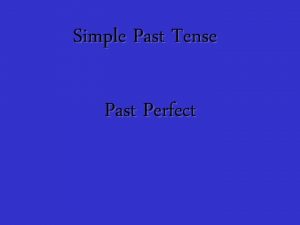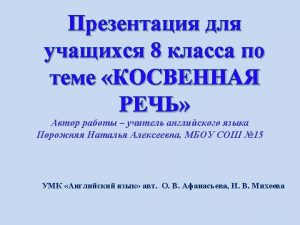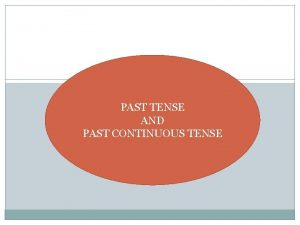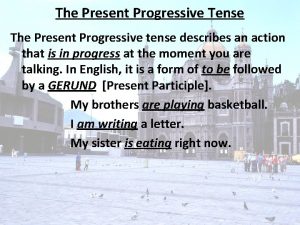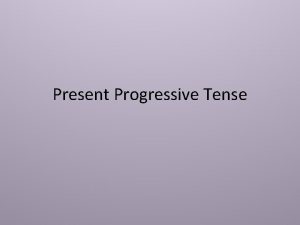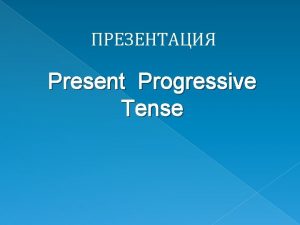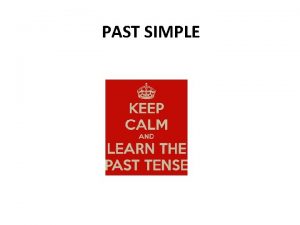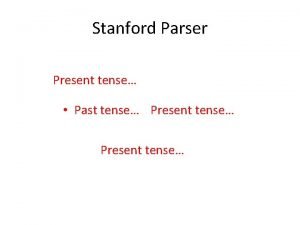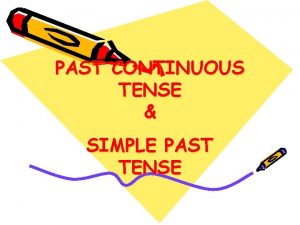Tense Review Simple Present Present Progressive Simple Past


























- Slides: 26

Tense Review: Simple Present, Present Progressive, Simple Past Prof. Myrna Monllor English 112 Copyright© August 2019

Simple Present Tense Is used for situations that happen every day or habitually every… always often never Time Expressions

Examples She brushes her teeth every morning. He always reads the newspaper in the morning. They often drink coffee during their break.

Notice that when the subject refers to he, she, or it you need to add S or ES to the verb. He always calls his girlfriend.

To express the negative in the present tense, you need to use doesn’t or don’t He doesn’t clean well. The child doesn’t like vegetables Doesn’t/Does not is used when The subject is he, she, or it.

They don’t have the answer. Don’t/Do not is used when the subject is I, you, we, they

To form a question using the present tense, you will also use do or does at the beginning of the question. Do you come to class every day? Does she cook? Notice that 1. Again the verb is in the basic form 2. Does is used with the subjects he, she, it

To form questions, you need to use Do or Does at the beginning of the question. Do they answer the phone? Does he play Nintendo DS? Notice the pattern of the question : Does + Subject + Simple Form of the Verb?

Exception The Verb Be The verb BE is the exception to all the rules, you NEVER use do or does to form the negative or the question form. I am young. I am not young. Am I young? You are pretty. You aren’t pretty. Are you pretty? She is lovely. She isn’t lovely. Is she lovely?

The Present Progressive Is used for an action that began in the past and is still happening. I am talking. You are writing. We are watching TV.

Notice that the present progressive has two parts. The auxiliary verb BE + the -ing form of the verb. I am studying. BE -ing form Because you are using the verb BE as an auxiliary verb, you follow the same rules as when BE is the main verb of the sentence.

The Past Progressive Is used for an action that was happening in the past. The past progressive has two parts. The auxiliary verb BE in the past + the –ing form of the verb. She was studying for the test. They were going to the party.

Simple Past Tense Is used to show actions that have already finished. One boxer lost. The other won.

To form the negative of a verb in the past tense, you need to use the auxiliary verb didn’t. They didn’t watch a movie. Notice that when you form the negative, the main verb is in the base or simplest form.

To form the question in the past tense, you need to use did at the beginning of the question. Did he crash his car? Notice that again the main verb will be in its simplest or base form.

Exception The Verb BE in the past : (was, were) You do not use did with was or were. I was tired. I wasn’t tired. Was I tired? They were worried. They weren’t worried. Were they worried?

The Present Perfect It is used when the action began in the past and still continues. To form the present perfect you need the verb HAVE + Past Participle of the verb I have taught English for many years. She has seen the movie four times. 1. Notice that you use has with the pronouns he, she, and it. 2. To form the question use have or has

The Past Perfect Indicates that an action was finished at some time in the past. To form the past perfect, you need the past of HAVE and the Past Participle of the verb He had completed the homework. We had eaten our lunch. To form the question use HAD

Other things to Remember 1 • Every sentence in English needs a subject, except if it’s an order. Subjects cannot be omitted like in Spanish. Está lloviendo. It is raining. Vamos al cine. We are going to the Movies Exception: Close the door, please. Open the window.

2 The subject and the verb have to agree. This means, you use a singular subject with the singular form of the verb and a plural subject with a plural form of the verb. This is especially important when you use some form of the present tense.

He surfs. He doesn’t surf. Does he surf? The child and her mother cook. They don’t cook. Do they cook?

3 Use adjectives and adverbs correctly. Adjectives describe the noun. They are placed before the noun. Adverbs describe the verb. They are good performers. adjective They sing well. adverb

4 • In general, when you start writing using a tense, you should continue using that same tense. • This means that if you are writing using the past tense, you should continue writing in the past tense throughout the paragraph.

Tenses that may be used together Present Tenses Past Tenses Simple Present Tense Present Progressive Present Perfect Future Simple Past Tense Past Progressive Past Perfect Would + Base Form (conditional past)

Examples This morning I woke up at 5: 30. I took a bath, had breakfast and then left to the university. I am a student at USC. I study journalism. I want to be a TV reporter.

Exercise 1. Where have you traveled? 2. When will you graduate? 3. What types of movies do you like to watch? 4. What did you eat for lunch? 5. What does your future profession require?
 Tense chart for class 3
Tense chart for class 3 Present tense simple and progressive
Present tense simple and progressive Simple present present progressive simple past
Simple present present progressive simple past Present and past simple and progressive
Present and past simple and progressive Present simple present progressive past simple
Present simple present progressive past simple Past simple past progressive past perfect
Past simple past progressive past perfect Past progressive and past simple
Past progressive and past simple Past perfect function
Past perfect function Past simple vs past continuous ejemplos
Past simple vs past continuous ejemplos Future tense
Future tense Passive present progressive
Passive present progressive Simple present present progressive
Simple present present progressive Past continuous tense clipart
Past continuous tense clipart Past progressive tense
Past progressive tense Present simple past simple
Present simple past simple Past simple remember
Past simple remember Perfect vs progressive
Perfect vs progressive Simple present tense drive
Simple present tense drive Simple present present perfect present progressive noredink
Simple present present perfect present progressive noredink Simple and progressive forms
Simple and progressive forms Progressive verb forms
Progressive verb forms Spend simple past form
Spend simple past form Simple past tense positive sentences
Simple past tense positive sentences Learning objectives of simple past tense
Learning objectives of simple past tense Simple past simple present simple future
Simple past simple present simple future презент перфект упражнения
презент перфект упражнения Simple future past
Simple future past

